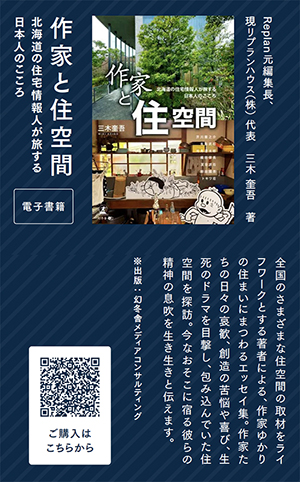


さて「奥の細道」など漂泊、旅に生きた詩人という印象の強い芭蕉さんですが、やはりホームポジションというものはあって、そこから各地に「旅立った」のだから住宅痕跡情報は残っている。その復元されたものが写真。東京江東区の「芭蕉記念館」にある。江東区はわたしも好き。若い勤め人として東京で住んでいるときにはひたすら「山の手」地域の目黒区にいたけれど、旅人して訪れるようになると逆に「下町」志向が強くなって清澄白河とか門前仲町などに惹かれホテルを取り隅田川周辺を朝散歩するようになっている。早朝散歩では東京駅八重洲口くらいまで足を伸ばしていて、その利便性の良さと庶民性に面白がっていた地域。
江戸初期の時代、この界隈がどのような街並みであったか想像すれば、やはり庶民的な風景だったように思える。江戸城などのおっかない雰囲気ではなく、隅田川の流路に沿って庶民が暮らしやすい生活圏が広がっていたことが想像できる。
一方で現代人としてはこの「わび住まい」では奥さんとかはどうしてたの?と疑問に思うけれど、芭蕉さんはとくに妻帯した形跡が乏しい。一応、寿貞尼(じゅていに)さんという「いい仲」(笑)だった女性はいたようだけれど、彼女は他の男性と夫婦関係で子どもも3人いたという。ただ、芭蕉さんの「身の回り」的なことには子どもも含めて関与したという情報もある。ちょっと現代常識とは違う男女関係だったようです。
なのだけれど、当時の江戸の街は妻帯して家を維持するというケースはむしろ稀な、地方からの若年男性人口集中大都市。地方の農家の次男3男層にとっては「長い出稼ぎ暮らし」というのが実情に近かったのだろう。だから吉原遊興などで「宵越しの金は持たない」破滅的な人生模様が一般性を持っていたのだろう。
そういう町ではこんな庵暮らしでもいっぱしの「宗匠」身分だったのか。いやむしろそういう家の保守安定方向ではない価値観が共有され、持家の意味合いが希薄だったのか。戦後社会での大都市流入人口の住宅建築、購入というわたしたちの「住宅市場観」とはまったく異質。
まぁ余談だけれどこれからの日本社会での住宅市場では、当然ながらその購入層の大変動が強く反映していく可能性が高くなってきていると思う。「出稼ぎ的」外国人問題など。

なお、芭蕉庵というこの家の名付けは「芭蕉」という植物由来。写真説明に「japanese Banana」という説明があったけれど、果実のバナナが成ることはない類縁種の植物。芭蕉という人名からは「佗茶」系植物を想像しがちだけれど、この「絵詞」の図からは完全に「イケてる」トンデモ風江戸オジさんなのかも。
●お知らせ
拙書「作家と住空間」幻冬舎から電子書籍で発刊
お求めはAmazonで。
https://amzn.asia/d/eUiv9yO

English version⬇
What Kind of House Did Basho Live In? / Journey Through Japanese 5-7-5 Rhythm - 8
The reconstruction of “Basho-an” in Fukagawa, Edo's lower town. Japanese banana = the plant Basho. The impact of Japanese garden aesthetics is like stepping into another world. ...
Now, while Basho is strongly associated with wandering and living for travel, as seen in works like The Narrow Road to the Deep North, he did have a home base. He “set out” from there to various places, so traces of his residence remain. The photo shows a restored version of this. It's at the Basho Memorial Museum in Koto Ward, Tokyo. I like Koto Ward too. When I lived in Tokyo as a young office worker, I stayed solely in the “Yamanote” area of Meguro Ward. But as I began visiting as a traveler, I developed a stronger preference for the “Shitamachi” neighborhoods. I found myself drawn to places like Kiyosumi-Shirakawa and Monzen-Nakacho, booking hotels there and taking morning walks around the Sumida River. During these early morning strolls, I'd often walk as far as the Yaesu Exit of Tokyo Station, enjoying the area's convenience and its down-to-earth, ordinary feel.
When I imagine what this neighborhood looked like in the early Edo period, it seems it was indeed a commoner's landscape. Unlike the intimidating atmosphere around Edo Castle, I can picture a livable community for ordinary people spreading out along the Sumida River's course.
On the other hand, as a modern person, I wonder, “What about wives in these ‘wabi-style dwellings’?” But there's little evidence that Basho was married. He did have a woman named Juteini, with whom he had a “close relationship” (laugh), but she was married to another man and had three children with him. However, there is also information suggesting she was involved in matters concerning Basho's “personal affairs,” including those related to his children. It seems their relationship was somewhat different from modern norms.
But Edo at that time was a major metropolis crowded with young men from the provinces, where maintaining a household with a wife was actually rare. For second or third sons from rural farming families, the reality was closer to a “long life of migrant labor.” That's probably why the self-destructive lifestyle of “never keeping money overnight”—spent on Yoshiwara pleasure quarters—was so common.
In such a town, even living in a hut like this made him a proper “master” figure. Or rather, perhaps values diverging from the conservative, stable path of homeownership were shared, making the concept of owning a house itself rather thin. This is entirely different from our postwar “housing market perspective” shaped by the housing construction and purchases of large-city influx populations.
Well, as an aside, I think the housing market in Japan going forward will likely see significant shifts strongly reflecting major changes in the purchasing demographic. Issues like the influx of “migrant worker-like” foreigners, for instance.
The name of this house, Basho-an, derives from the plant “basho.” The photo caption mentioned “Japanese banana,” but it's a related plant species that doesn't bear the fruit bananas. While the name ‘Bashō’ might make one imagine plants like “Wada-cha,” this “E-kotoba” illustration suggests he might have been a totally “cool” and outrageous Edo-period dude.
●Notice
My book “Writers and Living Spaces” published as an e-book by Gentosha
Available on Amazon.

































